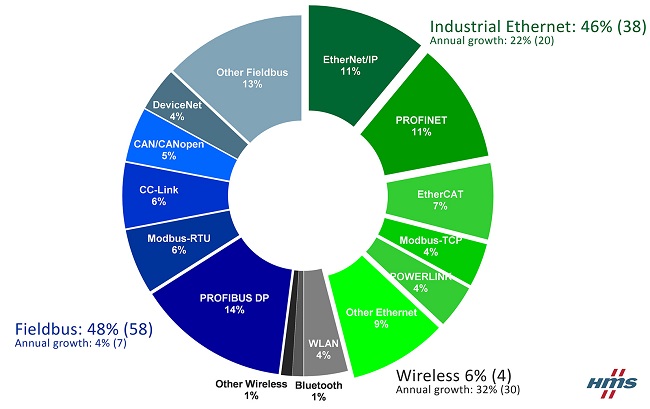HMS发布2017年工业网络市场份额报告
http://www.gkong.com 2017-02-24 17:12 《中华工控网》翻译
HMS Report: Industrial Ethernet and wireless growing fast in 2017
HMS报告:工业以太网和无线技术在2017年快速增长
February 21, 2017 - HMS Industrial Networks now presents their annual analysis of the industrial network market, which focuses on new installed nodes within factory automation globally. As an independent supplier of products and services for industrial communication and the Internet of Things, HMS has a substantial insight into the industrial network market. Here are some of the trends they see within industrial communication in 2017.
2017年2月21日——HMS工业网络公司发布了其工业网络市场的年度分析,重点是全球工厂自动化中的新安装节点。作为工业通信和物联网产品和服务的独立供应商,HMS对工业网络市场具有极强的洞察力。以下是他们对2017年工业通讯一些趋势的观察。

Industrial Internet of Things is boosting Industrial Ethernet growth
工业物联网促进工业以太网增长
According to HMS, industrial Ethernet is growing faster than previous years, with a growth rate of 22%. Industrial Ethernet now makes up for 46% of the global market compared to 38% last year. EtherNet/IP and PROFINET are tied at first place, with PROFINET dominating in Central Europe, and EtherNet/IP leading in North America. Runners-up globally are EtherCAT, Modbus-TCP and Ethernet POWERLINK.
根据HMS所言,工业以太网的增长速度比往年更快,增长率为22%。工业以太网现在占全球市场的46%,而去年为38%。 EtherNet / IP和PROFINET份额最大,其中PROFINET主要市场在中欧,EtherNet / IP在北美占主导地位。紧跟其后的是EtherCAT、Modbus-TCP和Ethernet POWERLINK。
“We definitely see an accelerated transition towards various industrial Ethernet networks when it comes to new installed nodes,” says Anders Hansson, Marketing Director at HMS. “The transition to industrial Ethernet is driven by the need for high performance, integration between factory installations and IT-systems, as well as the Industrial Internet of Things in general.”
HMS市场总监Anders Hansson表示:“看看新安装的节点,我们看到的无疑是加速向各种工业以太网网络过渡。大体上,向工业以太网过渡主要是受到对高性能、工厂设备和IT系统集成,以及工业物联网的需求驱动。”
Wireless is redefining the networking picture
无线正重新定义网络场景
Wireless technologies are growing quickly by 32% and now accounts for 6% of the total market. Within Wireless, WLAN is the most popular technology, followed by Bluetooth. “Wireless is increasingly being used by machine builders to realize innovative automation architectures and new solutions for connectivity and control, including Bring Your Own Device (BYOD) solutions via tablets or smartphones,” says Anders Hansson.
无线技术迅速增长32%,目前占总市场的6%。对于无线技术,WLAN最受欢迎,其次是蓝牙。“无线技术越来越多地被机器制造商用来实现创新自动化架构以及新的连接和控制解决方案,包括通过平板电脑或智能手机的自带设备办公(BYOD)解决方案,”Anders Hansson说道。
Fieldbus is still growing, but the growth is slowing down
现场总线仍在增长,但增长放缓
Fieldbuses are still the most widely used type of networks with 48% of the market. Fieldbuses are still growing as many users ask for the traditional simplicity and reliability offered by fieldbuses, but the growth rate is slowing down, currently at around 4% compared to 7% last year. The dominant fieldbus is PROFIBUS with 14% of the total world market, followed by Modbus-RTU and CC-Link, both at 6%.
现场总线仍然是使用最广的网络类型,占据48%的市场。现场总线仍在增长,因为现场总线传统的简单性和可靠性是许多用户看重的,不过增长率正在放缓,目前为4%,而去年为7%。占主导地位的现场总线是PROFIBUS,占全球市场的14%,紧跟其后的是Modbus-RTU和CC-Link,均为6%。
Regional facts
地域情况
In Europe and the Middle East, PROFIBUS is still the leading network while PROFINET has the fastest growth rate. Runners up are EtherCAT, Modbus-TCP and Ethernet POWERLINK.
在欧洲和中东地区,PROFIBUS仍然是领先的网络,而PROFINET的增长速度最快。其后是EtherCAT、Modbus-TCP和Ethernet POWERLINK。
The US market is dominated by the CIP networks where EtherNet/IP has overtaken DeviceNet in terms of market shares.
美国市场由CIP网络控制,其中EtherNet / IP在市场份额上已经超越DeviceNet。
In Asia, a fragmented network market is very visible. No network stands out as truly market-leading, but PROFIBUS, PROFINET, EtherNet/IP, Modbus and CC-Link are widely used. EtherCAT continues to establish itself as a significant network, and CC-Link IE Field is also gaining traction.
在亚洲,网络市场碎片化,没有作为真正主导性的网络,但PROFIBUS、PROFINET、EtherNet / IP,Modbus和CC-Link应用较广。EtherCAT继续自成一种重要网络,而CC-Link IE Field也在获得关注。
More and more devices are getting connected
越来越多的设备实现联网
“The presented figures represent our consolidated view, taking into account insights from colleagues in the industry, our own sales statistics and overall perception of the market,” says Anders Hansson. “It is interesting to see that industrial Ethernet and Wireless combined now account for more than half of the market at 52%, compared to fieldbuses at 48%. The success of a series of industrial Ethernet networks and the addition of growing Wireless technologies confirms that the network market remains fragmented, as users continue to ask for connectivity to a variety of fieldbus, industrial Ethernet and wireless networks. All in all, industrial devices are getting increasingly connected, boosted by trends such as Industrial Internet of Things and Industry 4.0. From our point of view, we are well-suited to grow with these trends, since HMS is all about ‘Connecting Devices.’”
“这些展示的数据代表了我们统一的视野,将我们业内同事的见解、我们自己的销售数据以及市场的总体预测均考虑在内,”Anders Hansson说。“有趣的是,工业以太网和无线合计现在占据了一半以上的市场,达52%,而现场总线占48%。一系列工业以太网网络的成功以及日益增长的无线技术的增加,证明了网络市场仍然分散,因为用户继续要求连接到各种现场总线、工业以太网和无线网络。总而言之,受到工业物联网和工业4.0等趋势的推动,越来越多的工业设备实现了联网。从我们的角度来看,基于HMS的座右铭‘Connecting Devices,’ 我们将顺应这些趋势持续成长。”
相关新闻
- ▪ ADI公司如何让IO-LINK和工业以太网在智能工厂车间通信
- ▪ Red Lion® 推出新款 N-Tron® NT116 非管理型 16 端口工业以太网交换机
- ▪ 图尔克高数据速率直通车 | 以太网产品线
- ▪ 现场总线,一场硝烟未息的战争
- ▪ 工业以太网市场预计到2032年将超过3500亿美元
- ▪ 红狮控制推出支持实时视觉感知的全新HDMI®功能,帮助客户提升生产效率
- ▪ 工业以太网和无线网络市场份额持续攀升- HMS 2023年工业网络市场份额报告
- ▪ 红狮控制迎来五十周年庆典
- ▪ 亚信电子荣登《金融时报》第五届亚太区高成长500强企业
- ▪ 国产化EtherCAT主站控制器解决方案,米尔基于全志T507-H核心板




